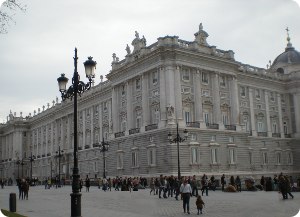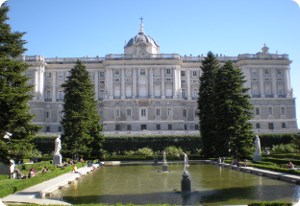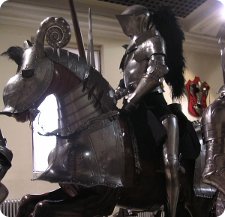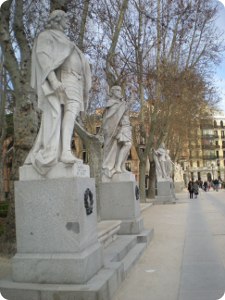Royal Palace
Top Attractions
Royal Palace:
 The Royal Palace (Palacio Real in Spanish) is not the official residence of his Majesty the King of Spain,
but rather where state ceremonies, official banquets and other state functions take place. The King lives
in Zarzuela Palace, which is just outside of Madrid.
The Royal Palace (Palacio Real in Spanish) is not the official residence of his Majesty the King of Spain,
but rather where state ceremonies, official banquets and other state functions take place. The King lives
in Zarzuela Palace, which is just outside of Madrid.
It is sometimes incorrectly referred to in Spanish as "Palacio de Oriente" due to its close
proximity to the "Plaza de Oriente" square, which is on the east (Oriental) side of the palace.
The origin of the palace dates back to the ninth century when the Muslim kingdom of Toledo built a defense that was
later used by the kings of Castile, who, during the 16th century, built the former Alcázar castle.
The current Royal Palace, was built on the site of the old Alcázar which was destroyed by fire on
Christmas Eve 1734. King Felipe V decided to build a palace for his Borbon dynasty.
The Italian Filippo Juvara was selected to design the new palace and his plans
were to create a grand palace along the lines of France's Versailles.
All construction was vaulted in stone and brick, not wood, so that any fire could destroy it.
The works were carried out between 1738 and 1755, Carlos III established his residence there in 1764.
 For interior decoration, rich materials were used: spanish marble, stucco, mahogany doors and windows and important works of art, particularly frescoes by leading artists of the moment as Giaquinto, Tiepolo and Mengs and his Spanish followers Bayeu and Maella.
For interior decoration, rich materials were used: spanish marble, stucco, mahogany doors and windows and important works of art, particularly frescoes by leading artists of the moment as Giaquinto, Tiepolo and Mengs and his Spanish followers Bayeu and Maella.
The decoration of the Royal Palace of Madrid has been changing over time according to the different artistic styles of the moment.
It has a central interior courtyard, whilst another courtyard, the "Plaza de Armas", on the south side, acts as
the principal entrance to the palace. This courtyard looks out on to the
Almudena Cathedral. The Palace occupies 13 hectares, has 870 windows,
240 balconies and 44 staircases.
Madrid's Royal Palace of is considered by many to be one of the finest palaces in Europe.
Royal Armoury and Royal Pharmacy:
 Inside the Palace is located the Royal Armoury.
Inside the Palace is located the Royal Armoury.
Considered together with the imperial of Vienna, one of the best in the world, consists of pieces ranging from
the 15th century onwards. These highlight the pieces of tournament made for Charles V and Philip II by leading
armorers of Milan and Augsburg.
Among the most remarkable pieces stands the armory and full tools that Emperor
Charles V used in the Battle of Mühlberg, and which was portrayed by Titian in the famous equestrian portrait of
the Museo del Prado.
Unfortunately, part of the armory was lost during the Peninsular War and during the Spanish
Civil War. Still, the armory retains some of the most important pieces of this art in Europe and worldwide.
Another interesting museum is the Royal Pharmacy. It features such treasures as cabinets for storing
medicinal herbs, containers, bottles, stills, prescriptions dispensed to the Royal Family. The bottles were
made in the factory of La Granja de San Ildefonso (Segovia).
Plaza de Oriente:
 The west side of Palace is located the Oriente Square.
It is of monumental character, whose final layout responds to a design in 1844 by Pascual y Colomer.
The west side of Palace is located the Oriente Square.
It is of monumental character, whose final layout responds to a design in 1844 by Pascual y Colomer.
The Plaza de Oriente is rectangular, although his head located to east, forming a closed curve, headed by the Royal Theatre.
It can distinguish three quadrants: the Central Gardens, the Cabo Noval Gardens and the Lepanto Gardens.
The Central Gardens are arranged around the central monument to Philip IV, in a grid, following the barroque model
garden. They consist of seven flowerbeds, each packed with box hedges, forms of cypress, yew and magnolia of small
size, and flower plantations, temporary. These are bounded on either side by rows of statues paths, popularly known
as the Gothic Kings, acting as line of division of the other two quadrants.
The sculpture collection, really, are of twenty Spanish kings corresponding to five Visigoth kings and fifteen
kings of the early Christians kingdoms in the Reconquista. These statues, made of limestone, are distributed in
two rows that cross the quadrant to east-west, on both sides of the Central Gardens.
Campo del Moro Gardens:
The Palace Gardens are called Campo del Moro.
These gardens are named after allegedly camped in this place the troops of the Muslim leader Ali ben Yusuf in 1109
during an attempted reconquest of Madrid. The first works to condition the area are due to Philip IV, whose reign
it were built fountains and planted different kinds of vegetation, but the overall look of the place remained
largely neglected. Not being until the reign of Isabel II in which started a landscaping more seriously.
At this time it design a big park of Romanticist style.
With the fall of Isabel II the gardens suffer a period of abandonment and neglect in which it lose a part of the
design and not until the regency of Maria Christina of Austria when it began a series of rehabilitation works,
giving the current design, which follows the layout of the English gardens of 19th century.
Directions:
Bailén Street, 6
28071 Madrid
Phone: +34 91 454 88 00, Fax: +34 91 542 69 47
https://www.patrimonionacional.es/
Open:
The palace is partially open to public, except when it is being used for official business.
Winter (October to March): Daily 10:00 to 18:00.
Summer (April to September): Daily 10:00 to 20:00.
Closed:
Important: This monument is closed for the celebration of Official Acts
[ more ].
* Lines 5 and 2 - Ópera station.



